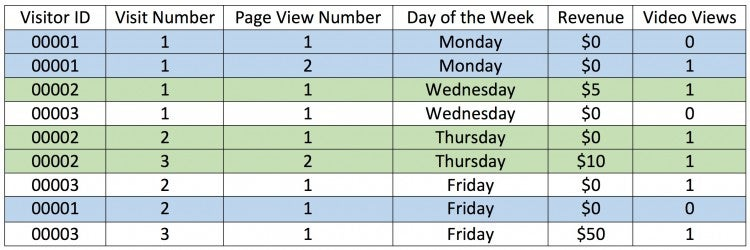Customer-Based Data for Actionable Insights

When I first arrived at Adobe I was overwhelmed with the amount of data available at my fingertips; it truly is a data scientist’s paradise. The data is so easily available in Adobe Analytics. I could quickly pull a report and see the behavior of a number of KPIs for my client and easily see which marketing channels were bringing in the most traffic. With my master’s degree in statistics in hand, I wanted so badly to apply the algorithms and models that I had just spent years learning about to the web analytics data of my clients. I quickly realized that many of the models in my toolkit required the data in a different form — I needed a customer-based data set.
Reports and Analytics, within Adobe Analytics, is great for macro-level analysis. I’m especially fond of the predictive features that have made their way into the user experience: contribution analysis and anomaly detection. However, a certain class of statistical methods and techniques require a subject-based data set. A subject-based data set is structured in rows and columns (like an Excel spreadsheet) — each row of the data set is a unique subject and each column is some piece of information about that subject. In the web analytics realm, site visitors and potential customers are the equivalent of subjects in a subject-based data set. If you want to do customer-based analysis, you will need a customer based data set.
In its most granular form, clickstream data looks like the chart below. Hits from the same visitor have been color coded together.

http://blogs.adobe.com/digitalmarketing/wp-content/uploads/2015/11/s1.jpg
For each visitor, we have several hits within a visit, and over an extended period of time we have a collection of visits. We need a way to organize the data at the visitor level. Something like this:

http://blogs.adobe.com/digitalmarketing/wp-content/uploads/2015/11/s2.jpg
Obviously, there are many different ways you could aggregate the data. For numeric data like page views, revenue and video views, we may want to use something like an average or total. For qualitative data like a marketing channel value, product type, or specific eVar value, we may want to use something like most common value or most recent value. Within Adobe’s consulting organization, the data science team has partnered with engineering services to build a platform for creating customer-based data sets quickly and efficiently. We leverage the latest big data technology to turn unorganized click-stream data into customer-based data sets. Our framework is totally flexible in building the data set that you need for analysis.
As mentioned earlier, once you have obtained a customer-based data set, there are a number of different statistical models and data science techniques that can allow you to access deeper, more meaningful analysis at the visitor level. Data Science Consulting has expertise and experience in leveraging these methods to:
- Predict which customers are at the highest risk for churn and determine the factors that are affecting that risk (allows you to be proactive in retaining your customer base)
- Understand the level of brand awareness of individual customers
- Target customers with individualized, relevant offers
- Anticipate which customers are most likely to convert and statistically determine how your site is influencing that decision
- Determine the types of site content that visitors are most likely to respond to and understand how content engagement drives high-value visits
- Define the profiles and characteristics of the different personas of visitors coming to your site, and understand how to engage with them
A customer-based data set combined with a robust data science regime is a very powerful instrument in a mature web analytics organization. Every moment, you are recording an abundance of information about individual customers. Hidden in that information is the key to turning those unknown visitors into long-time, repeat customers and engaged site users. Organizing your clickstream data into a customer-based data set and leveraging data science techniques is critical in taking full advantage of the data you are collecting. In a highly competitive landscape, most organizations can not afford to leave valuable information and insights on the table.